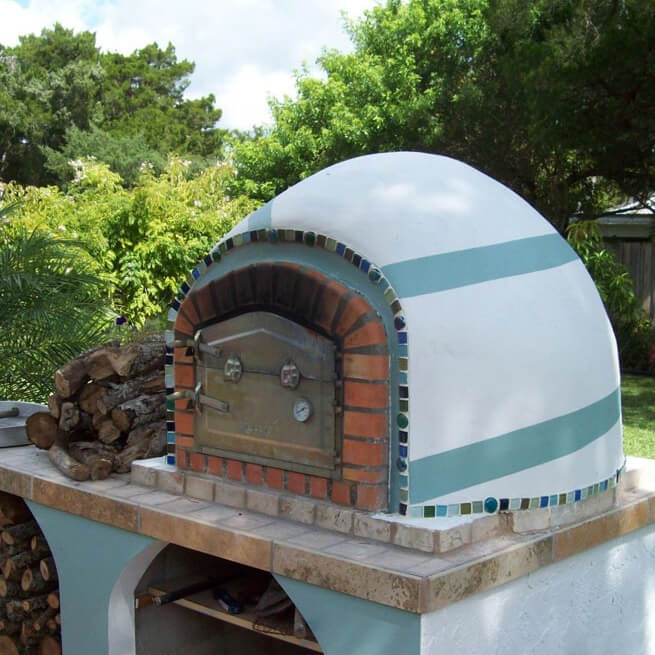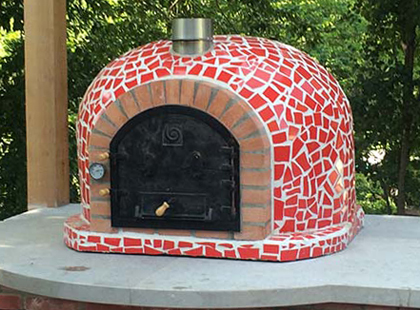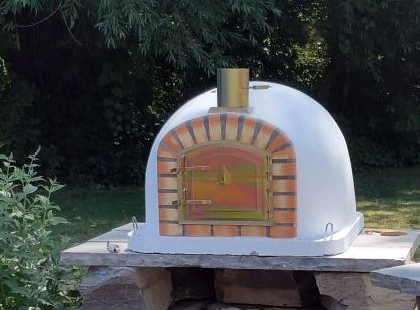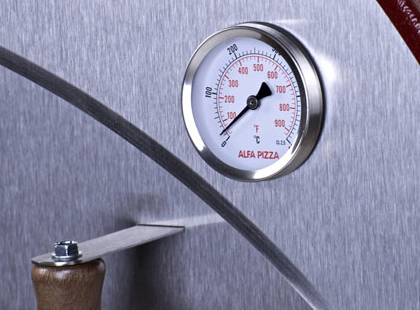
At Garden Gift Shop, we get asked many questions about our outdoor ovens. To help you choose the right oven for you, we have decided to put together a list of our most frequently asked questions from other customers who have bought our ovens. From assembly to painting advice, we have a varied list of questions that will hopefully answer all your queries. If, after reading, this article you still can’t find the information you need, then please don’t hesitate to get in touch. Our friendly team are always on hand to talk you through our products and make recommendations about what might suit you and your needs. It is also worth noting that when you purchase our ovens they come with full easy-to-follow instructions.
How is my outdoor oven delivered?
Your oven is delivered securely by a pallet company and will either be on a pallet or inside a protective pallet crate. This ensures your oven arrives in a safe and undamaged manner. We also add multiple layers of protective packaging to the crate to ensure no scratches or chips occur during delivery. When your oven arrives, we do recommend you inspect your outdoor oven before the driver leaves.
When will my outdoor oven be delivered?
We will call you to arrange a suitable delivery date. We will never send the oven out until we have contacted you. When arranging the delivery with you, we will need to confirm a convenient delivery date where there will be someone at the address all day to receive the delivery. We will also need confirmation there is good access to your property for the delivery lorry. For mainland UK addresses, the delivery will take two to three working days from dispatch. Remote or international orders are generally received in three to five working days from dispatch. If you have any questions about delivery before you place your order, please call us and we’ll be happy to talk you through the process.
The driver is contracted for a curbside delivery, which means delivering to the front of your property; they are not insured to park on your drive, so it is at their discretion how far they deliver the oven onto your property. They will unload it from the lorry using a pump truck. Due to the weight and the wheels of the pump truck, it can only operate on flat, hard surfaces. They would not be able to wheel the oven across grass or loose stones. You will need to plan how you move your oven into place before delivery.

Is my oven heavy?
All of our ovens are heavy, they are built using high-quality materials that allow you to cook at soaring hot temperatures. On each product page of the website, we will indicate the weight of the oven. For example, our clay and brick ovens tend to weigh in the region of 300 to 400 kgs. Weight will differ on a product basis depending on fuel type and material but you can check their weight on the product information. It should be assumed, however, that you won’t be able to lift the oven on your own and may require assistance – whether that’s extra people or some heavy lifting equipment. As a rule, the steel ovens are generally lighter in weight than the clay or brick ovens. However, we do have a traditional style oven that comes in pieces so can be moved by two or three people without the need for lifting machinery.
What is the best way to carry my oven?
Your oven is very heavy, so we would recommend you hire an engine hoist to help you lift and move the oven to your desired location.
How do I assemble an outdoor oven?
Most of our outdoor ovens come already assembled so you won’t have to do much to get your oven ready for use. Brick or clay outdoor ovens require curing before use but we have a guide for this. This essentially builds up the heat in your oven over a few days so your oven doesn’t get too hot too soon. It’s a precautionary measure used to dry out the moisture held in the oven.
You may also have to build a stand for your oven. Some models, like our Alfapizza ovens, do come with a stand, but our traditional ovens will require you make your own. Some people simply place their oven on top of a pile of breeze blocks. As long as your base can safely support the weight of your oven, you can use whatever materials you want. As a basic structure, we recommend two side walls with an inner support wall making an ‘H’ shape if looking from above. In terms of height, we recommend your oven sits at least 85cm to 95cm height from the ground, but this is only a guide. Always work to your own preference.
Can I use my outdoor oven in my garage?
You could keep your oven in your garage to protect it from the weather when not in use. When cooking, however, you should move it into an outdoor space. We have a safety guide for using pizza ovens and the same applies. You need to ensure you have appropriate ventilation to avoid smoke build-up and fire hazards. Covers are available for most of our ovens to keep it clean and lessen the moisture absorbed over a long period of wet weather.
How do I extinguish the fire in my oven?

The fire will extinguish naturally on its own after a period of time. You can assist by spreading the wood across the base of the oven, but you shouldn’t try to extinguish with water. If you have any ashes in the oven, you could also scoop them with a pizza peel and apply them to the fire. Closing the oven door will also get rid of any air supply that might be igniting the flame. Always check a fire is extinguished properly and has cooled down before doing anything to your oven.
Can I paint my oven a different colour?
Some outdoor ovens you can paint. For example, brick and clay models are okay to paint; stainless steel models, however, you wouldn’t be advised to paint. You should ensure you use a flexible heat-proof masonry paint for outdoor ovens as this will cope with the changing oven temperatures. Another popular method of customizing the outside of your oven is to cover it in colourful mosaic pieces for a totally unique design.
Can I move my oven while cooking?
No, it is really dangerous to move your oven while cooking. Your oven will get really hot and accidents could occur. The oven is also really heavy and when carrying the fire is likely to move. Your food could catch alight and the fire could get unruly.
We recommend you move your oven into a safe place before cooking. If your fire does get too high whilst cooking or you think you need more ventilation, don’t try and move it. Instead, add more dry hardwood logs to the fire, remove any residue from the oven (e.g. ashes) and leave the door slightly ajar. This should help control the fire and smoke.
My outdoor oven has started to grow mould inside?
Your outdoor oven will be manufactured with a protective layer to safeguard it against changing weather conditions. If you clean your oven, however, and don’t let it dry properly, you might notice mould starting to grow on the inside of your oven. This is an indication that the oven has absorbed a lot of moisture either from cleaning or from prolonged wet weather. If this is the case, wipe the mould with a cloth and cure your oven again to dry out the moisture. It’s important you only use a small fire in the centre of your oven when curing.

What ventilation does my oven include?
All ovens include a chimney as standard, to allow smoke to escape the oven and draw air through the oven for better airflow. You can additionally purchase a flue extension to help move fumes further away.
What can I cook in my oven?
You can use an outdoor oven to cook a variety of food types. They are most commonly known for producing the finest pizza ever known, but with a few additions, you can use them to cook almost anything. A lot of people use outdoor ovens to cook succulent joints of meat because the thorough cooking method creates the most perfect, tender, and mouth-watering dishes. We do recommend you cook meat over a tray, however, to avoid any grease staining the stone or dripping into the fire. Some people cook meat on a baking tray, rotisserie spit, or on a Tuscan grill with a drip tray underneath. Your outdoor oven is a more powerful version of your kitchen oven and cooks more evenly, so what you can cook in there is only limited by your imagination. You will find most dishes cook amazingly well in your outdoor oven.
What equipment do I need to cook in my oven?
This will depend on what you already have, the type of oven you have, and what you want to cook. The minimum you’d need for cooking is a thermometer so you can monitor the temperature of your oven, a brush for cleaning out your oven (this is particularly necessary if you have a wood-fired oven), and a pizza peel for placing food in and out of the oven. If you plan on cooking a lot of pizzas, a peel is ideal as it easily slides under the pizza for turning during cooking and removing from the oven. It should also be used for all other dishes as the long handle means you can safely manoeuvre your food out of the oven without getting too close to the heat. Grill trays, roasting spit, and a Tuscan grill are all great accessories for diversifying what and how you cook in your pizza oven. Don’t forget you can still use your ordinary kitchen pots and pans in an outdoor oven.
If you are unsure about what outdoor oven equipment is available, have a look at our accessories section.
What type of wood should I use?
If you have a wood-burning oven, you will need some fuel – you need to be careful about the wood you use. For best practice, always use dried hardwood. Dried hardwood burns at a more stable temperature and burns more cleanly so as not to fill your chimney with black soot. A build-up of soot in your chimney will affect airflow and consequently the effectiveness of your oven, so it is very important to use good quality wood.
When curing your oven, use either kindling or small chunks of wood initially before building up to larger pieces of wood. You can always add wood chips or chunks to the fire in your oven to add extra flavours to your food.

Outdoor Oven Buying Guide
Outdoor ovens come in a variety of styles and designs so it is important when selecting one for your garden that you know what to take into consideration. Our guide offers food for thought when making your decision.

Outdoor Ovens FAQs
To help you choose the right oven for you, we have put together a list of our most frequently asked questions from other customers. From assembly to painting advice, we have a varied list of questions that will hopefully answer all your queries.



